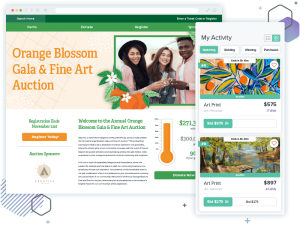Attending a fundraising conference is a whirlwind. There are lessons to learn, people to meet, vendors to visit, and parties to frequent. But our favorite part is the sessions we attend.
We love to tweet the highlights from each session so our friends and clients can follow along. Here are 13 of our top takeaways from this year’s International Fundraisers Conference and practical tips for applying them to your own fundraising.
1. Post-disaster fundraising presents some unique challenges. Here’s a big one.
About 6 months after a disaster, giving to disaster-relief causes stops. As a matter of fact, 2/3 of donations are made within the first 2 months. Plan accordingly! #AFPFC
— qgiv (@qgiv) April 15, 2018
Planning for disasters — both natural and manmade — is an unfortunate necessity for fundraisers. If you’re raising money immediately after a disaster, you can expect to see support dimish after the first few weeks. Donations generally stop rolling in after 6 months.
To mitigate that, make sure you include information about the long-term effects of the disaster and the importance of long-term support. As time progresses, share stories from families and individuals who are in the midst of recovery. Showing donors that you’re still supporting your community in the wake of a tragedy is the best way to show them how important their support is to the people you serve.
2. A flourishing development team requires the right personnel.
For small nonprofits, you ideally would want a 4-5 person development team. Gather the right people and resources and watch your major gift program flourish! #afpfc
— qgiv (@qgiv) April 15, 2018
Building an effective development team requires sufficient staffing… and that can be a huge obstacle for nonprofits with limited resources. In another session, we heard that board members and other department staff can understand building staff if you frame it appropriately. Try approaching staffing needs the way you’d approach an investment. Building a good development team is the only way to increase revenue that will fund your mission.
3. Board members can be a valuable resource for major gifts development.
Board members can be your supporters when it comes to major gifts. Don’t hesitate to reach out and ask. #AFPFC
— qgiv (@qgiv) April 15, 2018
Many nonprofits struggle to get their board personally involved in the fundraising process. If your donors aren’t comfortable directly asking their friends, family, and colleagues to support your cause, there’s another option. Ask them to introduce you to people they think are potential major donors. They may be uncomfortable asking for large gifts, but they may be okay with making connections and letting you ask, instead.
4. There’s more than one way to segment your donor base. Get creative!
A useful way to segment your donor base is by measuring their commitment to your mission. What questions can your #nonprofit ask to gauge commitment to your cause? Ask, then adjust your messaging to different segments. #afpfc
— qgiv (@qgiv) April 15, 2018
We’re huge fans of donor surveys. They help you build relationships, understand your donors’ motivations, and give you insight into which processes work and which don’t. They’re also a great way to gauge your donors’ commitment to your cause! Try asking questions about their willingness to volunteer, their passion for your cause, and other ways they support your mission. Very invested donors can be their own segment! That group will be more likely to volunteer, help with immediate needs, or give valuable feedback.
5. Specific asks out-perform vague appeals.
Make specific asks when crafting appeals, and be very clear about how donors’ gifts will be used. People connect psychologically to specific requests. The more ambiguous thr request, the more ambiguous supporters’ responses will be. #afpfc
— qgiv (@qgiv) April 15, 2018
Which appeal do you think is more effective? “Please give to alleviate poverty in our city” or “Please consider giving $50 to help people like Lisa feed their family?”
Hint: it’s the second one.
Donors like to be asked for specific actions or gifts. Vague appeals aren’t as effective as asking for concrete help! Here’s an example: instead of asking someone to “support your mission to alleviate poverty,” ask donors to give $50 to support a family in your area (you’ll want to include a great picture of a family here). Give donors a few options (only a few!) of levels of support. Just make sure the ask is specific.
6. Appeals are most effective when you keep your donors in mind.
Two major questions your donors will [subconsciously] ask when donating:
1. How will it make me feel?
2. How will it make a difference?Answer those two questions in your appeals — giving will be much more appealing.#afpfc
— qgiv (@qgiv) April 15, 2018
As a general rule, your donors don’t give because they love your organization. Donors give because they want to make a difference in the world and they want to feel good about doing it.
Keep those motivations in mind! If your donors want to know how their gift will make a difference, tell them. Tell them explicitly. Focus on making them feel good for making a difference. You’ll connect with donors on an emotional level, and that emotional connection is the starting point for an ongoing relationship with them.
7. Try capturing donor information on your thank-you page.
Idea: capitalize on the “high” a donor feels immediately after giving by asking a few brief (!!) questions on your thank-you page. #AFPFC
— qgiv (@qgiv) April 16, 2018
It’s a classic dilemma: you want to know about your donors, but asking additional questions on a donation form drives down completion rates. What’s a fundraiser to do?
Try asking questions on your thank-you page! Donors tend to be riding an emotional “high” immediately after they donate. Capitalize on it! Ask a couple of very brief questions on your thank-you page. It’s the perfect time to collect information about their motivations, passions, and ideas that will help you build relationships with them.
8. Dealing with boards can be a drag, but you can make it easier on yourself.
Your board has three responsibilities
1. Ethics and accountability
2. Financial oversight and ensuring resources
3. Raising fundsYou need to consider the first two responsibilities when you’re thinking about investing in fundraising. #afpfc
— qgiv (@qgiv) April 16, 2018
Boards can be the worst sometimes. It’s hard for them to get excited about new fundraising tools, campaigns, or methods. They’re not in the trenches with you! Making the case for additional tools or funding can be a huge obstacle.
Keep in mind that your board members’ responsibilities include maintaining good ethics and accountability. They’re also tasked with overseeing your expenditures and resources. In many places, board members may even be personally and legally responsible for any ethical or financial impropriety. That’s a huge contributing factor to boards’ somewhat legendary reluctance to change things up.
When requesting tools, resources, or money for fundraising expenses, remember the board’s responsibilities. Let board members know how you’ll use those tools and how they will work. Set up metrics that can track your success. Build transparency around your fundraising activities. All these pieces will help reassure board members and will help your case!
9. Donor retention methods pay for themselves.
Handwritten thank-you notes and a call on a donor’s anniversary of giving equalled a 30% donor retention rate and a 50% lift in a donor’s lifetime value. #afpfc
— qgiv (@qgiv) April 17, 2018
Donor-retention rates are pretty terrible in every part of the nonprofit industry. Even small gestures can make a big impression on donors!
One nonprofit shared two methods that were especially valuable. Nonprofit staff or board members sent handwritten thank-you notes to donors immediately after their gift. They also called each donor on the anniversary of their gift. The nonprofit retained more donors AND the donors they retained were 50% more valuable over their lifetime than donors who didn’t get those touches.
Time is a valuable resource for nonprofits. But spending some of that time on simple donor retention methods pays for itself.
10. Ditch the tiny remit forms in direct mail.
Pro tip: use full-size reply forms. Some donors, especially older donors, struggle a LOT with the tradtional forms and their tiny boxes and lines. Make reply forms big. Leave lots of white space. Make it easy for everyone to give. #afpfc
— qgiv (@qgiv) April 17, 2018
Love it or hate it, direct mail is still a huge moneymaker for fundraisers. And one of the best ways to make it cost-effective is to use full-size remit pages in your direct mail appeals.
Most of the people who give via direct mail appeals are older donors. The tiny lines and checkboxes on traditional remit forms are hard to use, especially when donors are older. Instead of using the traditional tear-off remit forms, include a full-page one, instead. Donors have more room to write, and that makes giving a gift easier. We’re always looking for ways to make it easy for donors to give. This is an easy one!
11. Focus on individual stories instead of staggering statistics.
“Scope insensitivity” is the phenomenon where people are overwhelmed and desensitized to huge problems. Make stories personal; focusing on 20,000 starving children overwhelms, but focusing on one starving child inspires more action. #AFPFC
— qgiv (@qgiv) April 17, 2018
If you’ve heard it once, you’ve heard it a thousand times; donors want stories, not stats. There’s a reason for that! “Scope insensitivity” means donors are overwhelmed to huge problems. 20.000 starving children seems like an impossible obstacle. Millions of displaced refugees seem overwhelming. But one starving child or one refugee puts a face on a problem. Donors may feel overwhelmed and hopeless by statistics, but they know they can help one person.
Put an individual face to your story. You might be solving global problems, but your donors need to know their contribution helps a real-life person. Show them those people.
12. Remember when we said to be specific? We meant it…
Don’t just say, “Please support us.”
Tell your donors what you need, why you need it, and the impact their gift will have. #AFPFC
— qgiv (@qgiv) April 17, 2018
It’s hard to remember sometimes, but donors don’t support nonprofits. They support the work nonprofits do. When you ask for support, don’t ask them to donate to YOU. Instead, tell them exactly the resources you need, why it’s important, and how it will help. Donors don’t care that your nonprofit needs money. Instead, they care that a local family needs food and shelter and that their $100 will buy them food for a week.
Be specific. Share stories. Show impact. It’s a recipe for fantastic fundraising campaigns.
13. Be intentional with the images you use.
Sad photos are most effective when making an ask.
Happy photos are most effective on remit pages/ donation pages and in follow-up communications. #AFPFC
— qgiv (@qgiv) April 17, 2018
At #AFPFC this year, we learned that imagery is one of the first elements donors notice. You might pour your heart and soul into crafting an amazing appeal letter… but donors will look at the pictures first.
Be intentional about how you use images! As a general rule, “sad” photographs are most effective when you’re making an ask. Show donors the problem they’re solving with their gift. Show them the people that need their support. Include emotionally compelling images on donation forms and in appeals (digital and direct mail). They’ll tug on donors’ heartstrings and reinforce your appeal.
Donors want to make a difference, right? Show them the difference they’ll make by using positive/happy imagery when they give. Happy images tell them, even just subconsciously, that they’re bringing hope and joy to people who need them. Happy photos belong on remit pages, donation confirmation pages, and follow-up communications.
Did you attend #AFPFC? What were your top takeaways?


